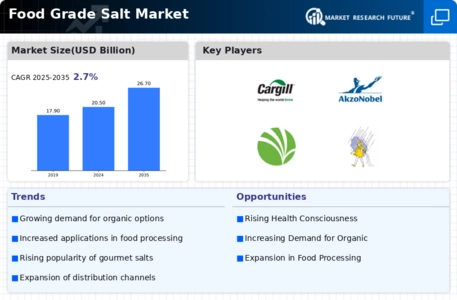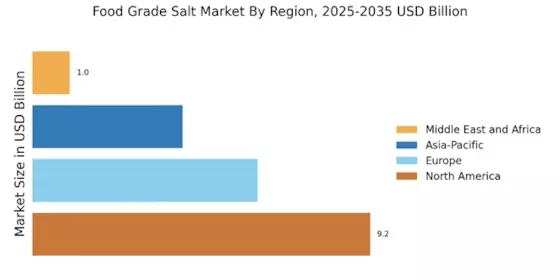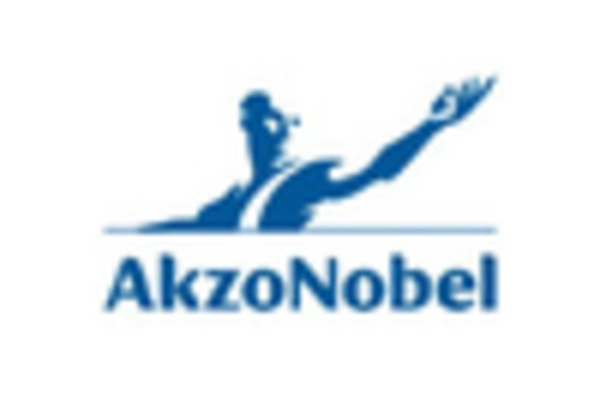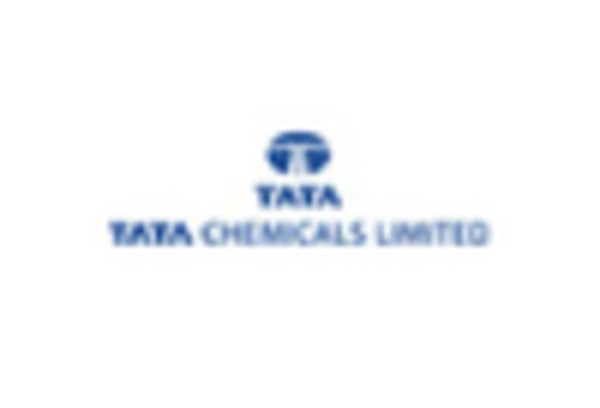Health Benefits of Food Grade Salt
The increasing awareness of health benefits associated with food grade salt is a notable driver in the Food Grade Salt Market. Consumers are becoming more health-conscious, seeking products that enhance their well-being. Food grade salt, particularly those enriched with minerals like potassium and magnesium, is perceived as a healthier alternative to regular table salt. This trend is reflected in market data, indicating that the demand for specialty salts, including Himalayan and sea salts, has surged by approximately 15% over the past year. As consumers prioritize health, the food grade salt segment is likely to experience sustained growth, driven by the desire for natural and minimally processed ingredients.
Regulatory Support for Food Safety
Regulatory support for food safety is an essential driver in the Food Grade Salt Market. Governments worldwide are implementing stringent regulations to ensure the safety and quality of food products. Food grade salt, being a critical ingredient in various food applications, is subject to these regulations, which often require higher purity standards. This regulatory framework not only enhances consumer confidence but also encourages manufacturers to invest in quality assurance processes. As a result, the food grade salt market is likely to benefit from increased demand for compliant products, as food producers strive to meet regulatory requirements and consumer expectations for safety.
Culinary Trends and Gourmet Cooking
Culinary trends emphasizing gourmet cooking and artisanal products are significantly influencing the Food Grade Salt Market. Chefs and home cooks alike are gravitating towards high-quality salts that enhance the flavor profiles of dishes. The rise of cooking shows and social media platforms has further popularized the use of specialty salts, such as fleur de sel and smoked salts. Market analysis indicates that the gourmet salt segment has seen a growth rate of approximately 10% annually, as consumers seek unique flavors and textures in their culinary experiences. This trend is likely to continue, driving innovation and variety within the food grade salt sector.
Emerging Markets and Economic Growth
Emerging markets and economic growth present a promising opportunity for the Food Grade Salt Market. As economies develop, there is a noticeable increase in disposable income, leading to changes in dietary habits and preferences. Consumers in these regions are increasingly adopting processed and convenience foods, which often contain food grade salt. Market projections indicate that regions such as Asia-Pacific and Latin America are expected to witness significant growth in food grade salt consumption, driven by urbanization and changing lifestyles. This trend suggests that the food grade salt market may experience robust expansion as these economies continue to evolve and consumer preferences shift.
Expansion of the Food Processing Sector
The expansion of the food processing sector is a critical driver for the Food Grade Salt Market. As the global population continues to grow, the demand for processed and packaged foods is on the rise. Food grade salt plays a vital role in food preservation, flavor enhancement, and texture improvement. Recent statistics suggest that the food processing industry is projected to grow at a compound annual growth rate of 4.5% over the next five years. This growth is expected to bolster the demand for food grade salt, as manufacturers increasingly rely on it to meet consumer preferences for convenience and quality in food products.


















Leave a Comment